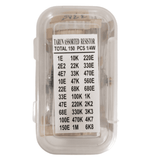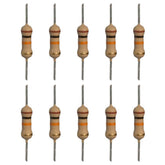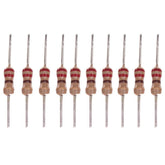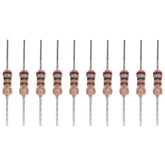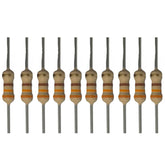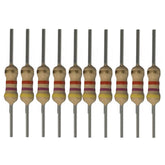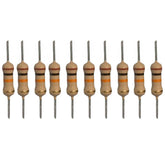What are smd resistors?
Summary
Discover the world of Surface Mount Device (SMD) resistors in our latest blog. Dive into the Introduction to understand the basics, explore the various Types of SMD Resistors, unravel the mystery behind the SMD Resistor Marking Scheme, and learn Techniques for Identifying these tiny components. Uncover the wide range of Applications and Circuit Uses that make SMD resistors indispensable. Join us on this electronic journey and gain valuable insights. Don't miss the CONCLUSION, where we wrap up the key takeaways. Unlock the potential of SMD resistors now! Click to enlighten your electronic knowledge.
Resistors are indispensable passive components found in every electronic circuit across countless applications. They restrict current flow to limit and control voltage levels. While through-hole resistors have been widely utilized, surface mount device (SMD) resistors have become ubiquitous with the rise of printed circuit board (PCB) technology and miniaturized electronics. This article will provide an extensive examination of the different types, sizes, markings, identification methods, and practical uses of SMD resistors.

Introduction
SMD resistors are designed to be soldered directly onto the surface of a PCB without wire leads passing through holes. The development of SMD technology in the 1960s was a breakthrough that allowed resistors and other components to be mass produced at much smaller sizes than their through-hole counterparts. Sony’s introduction of the first SMD resistors in 1966 launched a revolution in electronics manufacturing. The smaller passive SMD components enabled increased functional density and was a key factor that permitted the unprecedented miniaturization of electronic devices and systems seen today.

SMD resistors now come in a broad array of case sizes, shapes, and styles to suit the needs of different applications. Regardless of their physical appearance, all SMD resistors serve the same vital function - providing a fixed electrical resistance to restrict current flow in a circuit. Selecting the optimal SMD resistor requires careful consideration of operating parameters and the tradeoffs between precision, stability, power handling, cost, and other factors. Gaining a thorough understanding of the varieties, markings, sizes, and uses of SMD resistors is indispensable knowledge for electrical engineers, PCB designers, and anyone involved in circuit construction.
Types of SMD Resistors
While through-hole resistors rely on relatively simple carbon composition or wire-wound designs, numerous advanced materials and manufacturing processes have been developed over the decades to produce the various types of SMD resistors on the market today. Each type offers distinct performance characteristics and tradeoffs suitable for different applications and operating conditions. Some of the most common categories of SMD resistors include:
Thin Film Resistors
Thin film SMD resistors consist of an ultrathin resistive layer ranging from 0.01 to 0.3 microns thick deposited onto a tiny ceramic or silicon substrate. The thin film material is typically a metal oxide compound such as tantalum nitride (TaN), tin oxide (SnO2), silicon chromium (SiCr), or aluminum oxide. Palladium, platinum, and cermet compositions are also used in some types. The thin film deposition process allows for extremely tight resistance tolerances down to 0.05% along with low temperature coefficients and excellent long-term stability compared to other SMD resistor varieties.

Thin film SMD resistors are capable of precision resistance values from 10 ohms up to 10 megohms. However, their limited film thickness results in lower power handling capabilities. Thin film SMD resistors are ideal for applications requiring high precision and stability like laboratory instrumentation, medical devices, and industrial process control systems.
Thick Film Resistors
As the name suggests, thick film SMD resistors have a much thicker resistive layer ranging from 0.5 to 15 microns produced by firing a printed paste containing conductive and resistive ceramic particles onto a substrate at high temperature. The thicker resistive layer provides increased power handling capabilities compared to thin film resistors.

Thick film SMD resistors also offer a broader range of resistance values from just 1 ohm up to a staggering 22 megohms. However, their temperature dependence, tolerance, and stability specifications are generally inferior to thin film types. Active device hybrid circuits and automotive applications often utilize thick film SMD resistors thanks to their balance of medium precision, higher power handling, and lower cost.
Metal Foil Resistors
Constructed from a thin foil of resistive alloy such as nichrome, tantalum nitride, or a nickel-chromium alloy, metal foil SMD resistors achieve very low temperature coefficients down to ±1 ppm/°C for exceptional stability. The foil material also promotes consistent homogeneous properties.

However, the exposed resistive element is relatively fragile and prone to physical damage. Metal foil SMD resistors have intermediate resistance values ranging from 0.1 ohm to 1 megohm with power handling up to 3 watts. Applications include precision current sensing, feedback circuitry, and differential amplifiers.
Wire-wound Resistors
As the name implies, wire-wound SMD resistors consist of a high purity wire wrapped around an insulating ceramic mandrel or core. The actual wire material is typically Nickel-Chromium or copper-nickel alloy.

Wire-wound construction allows higher power handling capabilities due to the greater surface area exposure of the coiled wire element. Inductance effects can limit their usefulness to low frequency applications only. Wire-wound SMD resistors are available from 0.1 ohm up to 300 kilohms with power handling over 5 watts. Common applications include power supplies, power amplifiers, motor controllers, and high voltage test equipment.
Carbon Film Resistors
Carbon film SMD resistors contain microscopic particles of carbon mixed into a binder and coated onto a ceramic rod or cylindrical body. They represent the simplest and most cost-effective SMD resistor available today.

Carbon film resistors offer stability and low cost for general purpose applications but suffer from significantly higher noise and poorer tolerance compared to other types. Resistance values span from just 1 ohm up to 22 megohms. Rated power is typically 1/8 to 1/4 watt. Carbon film SMD resistors see abundant usage in all types of consumer electronics where precision is not critical.
In addition to these common varieties, other more specialized SMD resistor types also exist including metal oxide film, carbon composition, conductive polymer, and cermet thin film resistors. Clearly there is no single ideal resistor but rather each type provides certain advantages and tradeoffs in terms of precision, stability, power rating, operating temperature range, cost, and other parameters. Identifying the optimal SMD resistor requires a thorough understanding of the application requirements and operating conditions. Extensive manufacturer datasheets provide the key specifications and limitations to guide proper SMD resistor selection for a given circuit design.
SMD Resistor Sizing Standards
The diminutive size of SMD resistors is a direct result of the miniaturization made possible by SMD technology. While through-hole resistors are large enough to be handled by tweezers or fingers, SMD sizes can be as small as 1 mm in length and a fraction of a millimeter wide. The industry standardized SMD resistor sizes according to the metric Imperial measuring system based on thousandths of an inch.
The most common SMD resistor sizes today include 0201, 0402, 0603, 0805, 1206, 1210, 2010, 2512 although other sizes also exist for specialized applications. As an example, the 0603 resistor measures 0.06" x 0.03" while the larger 2512 measures 0.25" x 0.12". The first two digits denote the width and the second two digits represent the length in inches. Generally, smaller SMD resistor sizes enable higher functional densities in circuit designs but pose challenges for pick-and-place handling and soldering processes.
Larger SMD resistors can handle substantially higher power levels. Of course, component placement is also a consideration when selecting resistor sizes. As a best practice, the largest resistor sizes should be avoided when placing components in crowded areas near tall objects like capacitors or heat sinks on a PCB.
SMD Resistor Marking Scheme
Given their minuscule size, it is not possible to print the full resistance value and specifications on the body of SMD resistors. Instead, a compact marking scheme is used to denote the critical resistance characteristics. These tiny laser etched or printed markings consist of numerals and letters printed directly onto the component. The first two or three digits represent the significant figures of the resistor value in ohms units.
A letter multiplier denotes the magnitude in units of 10 such as M for mega or G for giga. Examples include 474K to signify 470 x 103 ohms or 470 kilohms and 301M for 300 x 106 ohms or 300 megohms. Values under 100 ohms may be marked without a multiplier letter. The tolerance or precision may be indicated by letters such as F for ±1%, G for ±2%, J for ±5%, and K for ±10%. Additional marking bands or stripes can sometimes be used to encode the temperature coefficient, reliability level, or date code. Properly interpreting SMD resistor markings is indispensable for circuit design, analysis, troubleshooting, and manufacturing quality control.
Techniques for Identifying Mystery SMD Resistors
With the plethora of sizes and lack of wire leads on chip resistors, identifying unknown SMD resistors can be challenging. Here are some helpful tips for distinguishing resistors from capacitors, diodes, and other small SMD components:
- Carefully examine the markings - numeric values followed by letter multipliers like 105K are a key indicator of resistors.
- Check for a color code - some types still use traditional 4, 5, or 6 color bands to encode resistance.
- Inspect for terminal bands - two gold or silver bands at each end denote the resistor terminals.
- Note the package size and shape - common resistor sizes are 0603, 0805, 1206 with rectangular or cylindrical bodies.
- Look at the body color - beige bodies are typically associated with resistors while capacitors are often yellow or blue.
- Consider nearby components - resistors may be clustered together in the same area of a circuit board.
- Use a multimeter to measure - connecting an ohmmeter or multimeter across the terminals reveals the resistance.
With practice, even small 0201 chip resistors can be quickly identified using visual cues and verifying with multimeter measurements. When in doubt, the microscopic markings provide the authoritative values and specifications.
For production testing and quality control, specialized automated optical inspection systems are indispensable for rapidly reading and validating SMD resistor codes and values.
Applications and Circuit Uses of SMD Resistors
Now that we have a firm grasp on the various types, sizes, markings, and identification methods, let's examine some of the crucial applications and circuit uses of SMD resistors:
- Current Limiting – One of the most elementary uses of resistors is to limit current flow through portions of a circuit. Fixed value SMD resistors are ubiquitously used to reduce currents to safe levels, especially in voltage regulation, power supply conditioning, and battery charging applications.
- Voltage Dividers – Series-parallel resistor divider networks created with SMD resistors enable higher supply or reference voltages to be stepped down to lower predictable levels appropriate for analog sensor, ADC, or control circuitry. Resistive dividers allow high voltages to be safely monitored and measured.
- Pull-up/Pull-down – When used between signal lines and power or ground rails, SMD resistors act as pull-up or pull-down resistors establishing default high or low logic levels in digital circuits. This prevents signals from floating to ambiguous voltage levels during transitions.
- Timing Circuits – Resistor-capacitor (RC) networks are universally used to provide timing delays in oscillators, pulse and multivibrator circuits, monostable multivibrators, and multiplexed logic. The resistor value determines the RC time constant.
- ESD Protection – Placing small value SMD resistors on supply busses and data communication lines helps protect sensitive CMOS ICs against electrostatic discharge damage by absorbing and limiting transient spike voltages.
- Current Sensing – Monitoring load current levels is achieved by placing an ultra-low ohm SMD sense resistor in series with the load to create a small measurable voltage drop proportional to the current.
- Termination – SMD resistors matched to the transmission line impedance are used to terminate lines and absorb signals, preventing problematic reflections in high-speed digital circuits.
This overview covers just a sample of the countless ways SMD resistors are applied in everyday electronics to make circuits perform as intended. They are truly the hidden heroes inside every electronic gadget and appliance.
Conclusion
As this article has explored, surface mount resistors continue to be a universal building block enabling the functionality and reliability of modern electronic systems. We examined the various types, sizes, markings, identification methods, and circuit applications related to SMD resistors. Their ability to provide stable, precise resistance values allows control and monitoring of current and voltage levels in virtually any circuit.
Matching the optimum SMD resistor characteristics and specifications to the particular application requirements and operating conditions is critical. With a deeper understanding of every facet of these tiny components, engineers and technologists can fully utilize SMD resistors and achieve robust, efficient, and innovative circuit designs. The ongoing development of new and improved SMD resistor materials and manufacturing processes promises continuing advances in precision, power handling, and reliability.
Frequently Asked Questions
1. What is a SMD resistor?
A surface-mount device (SMD) resistor is a crucial component in electronic circuits designed to restrict or limit the flow of current. Unlike traditional resistors, SMD resistors come in compact sizes and are directly soldered onto printed circuit boards (PCBs), eliminating the need for drilling and mounting holes. SMD resistors play a vital role in ensuring optimum performance and longevity of various electrical devices such as smartphones, laptops, televisions, etc. These miniature yet powerful components offer improved accuracy and stability while also reducing manufacturing costs due to their automated assembly process. So if you're looking for reliable resistance solutions for your next project, consider incorporating high-quality SMD resistors into your design.
2. How do you read a SMD resistor?
The SMD (Surface Mount Device) resistor is a commonly used component that plays a crucial role in electronic circuitry. Reading an SMD resistor may seem daunting at first for someone new to this field; however, it can be easily deciphered by following a few simple steps. Firstly, one must identify the value of resistance indicated by either color-coded bands or alphanumeric codes on the top surface of the resistor. Secondly, understanding and interpreting these codes correctly will help determine its tolerance level and wattage rating accurately. With practice and attention to detail, reading an SMD resistor becomes effortless.
3. What is the value of SMD resistor?
SMD resistors are a vital component in the world of electronics, with their value being unmatched. These miniature yet robust elements serve an essential purpose of regulating current flow and ensuring efficient performance of electronic devices. Utilizing surface mount technology (SMT), SMD resistors offer numerous advantages over traditional through-hole varieties - compact size, reduced weight, enhanced accuracy and reliability, and improved thermal capabilities. This has led to a high demand for these components across various industries including automotive, aerospace, telecommunications, and medical equipment manufacturing. As the market shifts towards smaller and more advanced products, the importance of SMD resistors only continues to grow, making them crucial for any successful electronic project or product.
4. What does SMD mean in electronics?
SMD stands for Surface Mount Device. These components are designed to be mounted directly onto the surface of printed circuit boards (PCBs). SMD technology allows for smaller, lighter devices, making it a popular choice in modern electronics for efficient use of space and improved performance.
5. How do SMD resistors differ from through-hole resistors?
SMD resistors are smaller and mounted directly on the PCB surface, while through-hole resistors pass through holes in the board. SMD resistors provide a more compact design and enable higher component density, whereas through-hole resistors are easier to handle and replace, often used in prototyping and DIY projects.
6. How can I read SMD resistor codes?
SMD resistor codes are generally expressed in a three-digit or four-digit code, indicating resistance values. The first two or three digits denote significant figures, while the last digit indicates the multiplier. For example, a code of "104" means 10 followed by four zeros, equaling 100,000 ohms or 100k ohms.
7. What are the standard sizes of SMD resistors?
SMD resistors come in various standard sizes, including 0402, 0603, 0805, 1206, and 2010. The numbers indicate the dimensions in inches. Smaller sizes, like 0402, are used for mobile devices, while larger sizes can handle higher power in more robust applications.
8. Where are SMD resistors commonly used?
SMD resistors are widely used in compact electronic devices like smartphones, tablets, and laptops. They're also prevalent in automotive electronics, medical devices, and telecommunications due to their efficient space usage and enhanced performance in high-density applications.
1. What is a SMD resistor?
A surface-mount device (SMD) resistor is a crucial component in electronic circuits designed to restrict or limit the flow of current. Unlike traditional resistors, SMD resistors come in compact sizes and are directly soldered onto printed circuit boards (PCBs), eliminating the need for drilling and mounting holes. SMD resistors play a vital role in ensuring optimum performance and longevity of various electrical devices such as smartphones, laptops, televisions, etc. These miniature yet powerful components offer improved accuracy and stability while also reducing manufacturing costs due to their automated assembly process. So if you're looking for reliable resistance solutions for your next project, consider incorporating high-quality SMD resistors into your design.
2. How do you read a SMD resistor?
The SMD (Surface Mount Device) resistor is a commonly used component that plays a crucial role in electronic circuitry. Reading an SMD resistor may seem daunting at first for someone new to this field; however, it can be easily deciphered by following a few simple steps. Firstly, one must identify the value of resistance indicated by either color-coded bands or alphanumeric codes on the top surface of the resistor. Secondly, understanding and interpreting these codes correctly will help determine its tolerance level and wattage rating accurately. With practice and attention to detail, reading an SMD resistor becomes effortless.
3. What is the value of SMD resistor?
SMD resistors are a vital component in the world of electronics, with their value being unmatched. These miniature yet robust elements serve an essential purpose of regulating current flow and ensuring efficient performance of electronic devices. Utilizing surface mount technology (SMT), SMD resistors offer numerous advantages over traditional through-hole varieties - compact size, reduced weight, enhanced accuracy and reliability, and improved thermal capabilities. This has led to a high demand for these components across various industries including automotive, aerospace, telecommunications, and medical equipment manufacturing. As the market shifts towards smaller and more advanced products, the importance of SMD resistors only continues to grow, making them crucial for any successful electronic project or product.
4. What does SMD mean in electronics?
SMD stands for Surface Mount Device. These components are designed to be mounted directly onto the surface of printed circuit boards (PCBs). SMD technology allows for smaller, lighter devices, making it a popular choice in modern electronics for efficient use of space and improved performance.
5. How do SMD resistors differ from through-hole resistors?
SMD resistors are smaller and mounted directly on the PCB surface, while through-hole resistors pass through holes in the board. SMD resistors provide a more compact design and enable higher component density, whereas through-hole resistors are easier to handle and replace, often used in prototyping and DIY projects.
6. How can I read SMD resistor codes?
SMD resistor codes are generally expressed in a three-digit or four-digit code, indicating resistance values. The first two or three digits denote significant figures, while the last digit indicates the multiplier. For example, a code of "104" means 10 followed by four zeros, equaling 100,000 ohms or 100k ohms.
7. What are the standard sizes of SMD resistors?
SMD resistors come in various standard sizes, including 0402, 0603, 0805, 1206, and 2010. The numbers indicate the dimensions in inches. Smaller sizes, like 0402, are used for mobile devices, while larger sizes can handle higher power in more robust applications.
8. Where are SMD resistors commonly used?
SMD resistors are widely used in compact electronic devices like smartphones, tablets, and laptops. They're also prevalent in automotive electronics, medical devices, and telecommunications due to their efficient space usage and enhanced performance in high-density applications.



